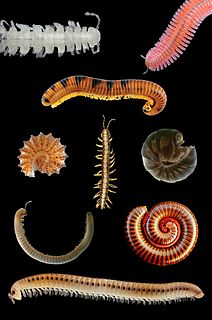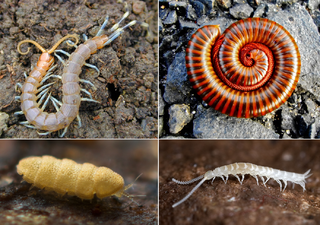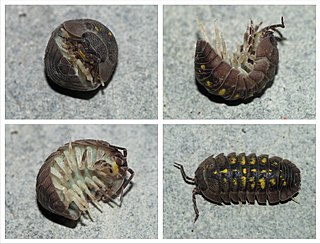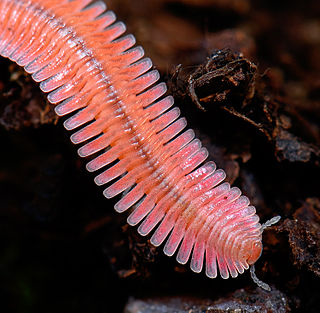
Millipedes are a group of arthropods that are characterised by having two pairs of jointed legs on most body segments; they are known scientifically as the class Diplopoda, the name derived from this feature. Each double-legged segment is a result of two single segments fused together. Most millipedes have very elongated cylindrical or flattened bodies with more than 20 segments, while pill millipedes are shorter and can roll into a ball. Although the name "millipede" derives from the Latin for "thousand feet", no species was known to have 1,000 or more until the discovery of Eumillipes persephone, which can have over 1,300 legs. There are approximately 12,000 named species classified into 16 orders and around 140 families, making Diplopoda the largest class of myriapods, an arthropod group which also includes centipedes and other multi-legged creatures.

Myriapoda is a subphylum of arthropods containing millipedes, centipedes, and others. The group contains about 13,000 species, all of them terrestrial.
Millipede memory is a form of non-volatile computer memory. It promised a data density of more than 1 terabit per square inch, which is about the limit of the perpendicular recording hard drives. Millipede storage technology was pursued as a potential replacement for magnetic recording in hard drives and a means of reducing the physical size of the technology to that of flash media.

Armadillidiidae is a family of woodlice, a terrestrial crustacean group in the order Isopoda. Unlike members of other woodlice families, members of this family can roll into a ball, an ability they share with the outwardly similar but unrelated pill millipedes and other animals. This ability gives woodlice in this family their common names of pill bugs or roly polies. Other common names include slaters,potato bugs, and doodle bugs. Most species are native to the Mediterranean Basin, while a few species have wider European distributions. The best known species, Armadillidium vulgare was introduced to New England in the early 19th century, and has become widespread throughout North America.

Arthropleuridea is an extinct subclass of myriapod arthropods that flourished during the Carboniferous period, having first arose during the Silurian, and perishing due to climate change just before the Early Permian. Members are characterized by possessing diplosegement paranotal tergal lobes separated from the body axis by a suture, and by sclerotized plates buttressing the leg insertions. Despite their unique features, recent phylogenetic research suggests Arthropleuridea be included among millipedes in the class Diplopoda. The subclass contains three recognized orders, each with a single genus.

Pill millipedes are any members of two living orders of millipedes, often grouped together into a single superorder, Oniscomorpha. The name Oniscomorpha refers to the millipedes' resemblance to certain woodlice (Oniscidea), also called pillbugs or "roly-polies". However, millipedes and woodlice are not closely related ; rather, this is a case of convergent evolution.

Arthropleura is a genus of extinct millipede arthropods that lived in what is now North America and Europe around 345 to 295 million years ago, from the Viséan stage of the lower Carboniferous Period to the Sakmarian stage of the lower Permian Period. The species of the genus are the largest known land invertebrates of all time, and would have had few, if any, predators.

Tachypodoiulus niger, known variously as the white-legged snake millipede or the black millipede, is a European species of millipede. It is very similar to other species such as Cylindroiulus londinensis, from which it can be reliably distinguished only by studying the shape of the telson. It occurs in Ireland, Britain, Spain, France, Benelux, Germany, Switzerland, Austria and the Czech Republic, and is especially common on chalky and limestone soils.

Glomerida is an order of pill-millipedes found primarily in the Northern Hemisphere. They superficially resemble pill-bugs or woodlice, and can enroll into a protective ball. They have twelve body segments, 17 to 19 pairs of legs, and males have enlarged rear legs involved in mating. The order includes about 30 genera and at least 280 species, including Glomeris marginata, the common European pill-millipede. The order contains members in Europe, South-east Asia and the Americas from California to Guatemala. Although historically considered closely related with the similar sphaerotheriidans that also enroll, some DNA evidence suggest they may be more closely related to glomeridesmidans, a poorly known order that does not enroll.

Spirostreptida is an order of long, cylindrical millipedes. There are approximately 1000 described species, making Spirostreptida the third largest order of millipedes after Polydesmida and Chordeumatida.

Polydesmida is the largest order of millipedes, containing approximately 3,500 species, including all the millipedes reported to produce hydrogen cyanide (HCN).

Sphaerotheriida is an order of millipedes in the infraclass Pentazonia, sometimes known as giant pill millipedes. They inhabit Southern Africa, Madagascar, South and Southeast Asia, Australia and New Zealand. Like the Northern Hemisphere pill millipedes of the order Glomerida, these millipedes can roll into a ball when disturbed. When they are rolled-up, most sphaerotheriidans reach a maximum size of a cherry or golf ball, but some species from Madagascar can even reach the size of an orange. When rolled-up, predators are unable to unravel giant pill millipedes since the margins of their second and last dorsal plates fit perfectly into one another, creating a sealed ball. A few giant pill millipede species are able to produce sound, the only millipedes known to do this. This order of millipedes is also unique in that some African species are used for medicinal purposes.

Paradoxosomatidae, the only family in the suborder Paradoxosomatidea, is a family of flat-backed millipedes in the order Polydesmida. Containing nearly 200 genera and 975 species as of 2013, it is one of the largest families of millipedes. Paradoxosomatids occur on all continents except Antarctica, and can generally be distinguished by dorsal grooves on most body segments and a dumb-bell shaped gonopod aperture. Notable groups within the Paradoxosomatidae include the dragon millipedes of Southeast Asia, and the widely introduced Greenhouse Millipede Oxidus gracilis.

Archipolypoda is an extinct group of millipedes known from fossils in Europe and North America and containing the earliest known land animals. The Archipolypoda was erected by Scudder (1882) but redefined in 2005 with the description of several new species from Scotland. Distinguishing characteristics include relatively large eyes with densely packed ocelli, and modified leg pairs on the 8th body ring. Some species had prominent spines while others had a flattened appearance.

Platydesmida is an order of millipedes containing two families and over 60 species. Some species practice paternal care, in which males guard the eggs.

Zosterogrammidae is an extinct family of millipedes containing three genera, each with a single species. Fossils are known from the Czech Republic, Scotland, and the USA. Zosterogrammidae constitutes the sole family of the order Zosterogrammida.

Ommatoiulus sabulosus, also known as the striped millipede, is a European millipede of the family Julidae. Its common name comes from its two striking bright longitudinal bands on the dorsal surface.

Euphoberiidae is an extinct family of archipolypodan millipedes known from the Upper Pennsylvanian of Europe and North America. The family includes relatively large millipedes measuring up to 30 cm (12 in) long bearing distinctive spines and were the dominant millipedes of the Pennsylvanian.

The Archidesmida is an extinct order of millipedes known from fossils from the Devonian period of Europe and North America. Archidesmidans have broad flat keels (paranota) extending from their body segments, and a modified pair of legs on the 8th segment that may have been involved in mating, similar to the gonopods of living millipedes which insert sperm into females. Alternately, the modified legs may have been used to grasp onto partners during mating.

Juliformia is a taxonomic superorder of millipedes containing three living orders: Julida, Spirobolida, and Spirostreptida, and the extinct group Xyloiuloidea known only from fossils. The species possess long cylindrical bodies with sclerites fused into complete rings. Juliform millipedes possess defensive repugnatorial glands on all body segments except the last few, and are the only known millipedes to produce quinones in their defensive secretions. Juliform males have two pairs of gonopods consisting of the modified 8th and 9th pair of legs: in Julida and Spirobolida the posterior gonopods are primarily involved in sperm-transferring, while in Spirostreptida it is the anterior gonopods. Juliformians also lack Tömösváry organs and have a large collum which overhangs the rear of the head.



















